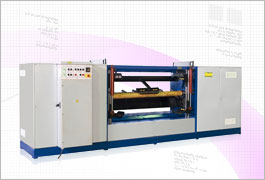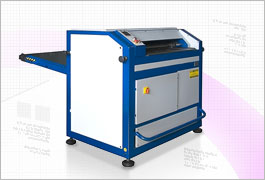|
| CALL+38 (067) 460-27-20 | English Ðóññêèé |

|
Articles
|
Product innovation from "MAGR". Equipment for peeled veneer production and splittingVeneer production with subsequent manufacturing of various goods thereof is one of the most prospective trends in wood processing nowadays. There are several reasons for such popularity: first, ecological compatibility of the material, second, minimal waste during production, and third - wide variety of goods manufactured from veneer as initial material. Veneer is a thin layer of natural wood. According to production methods it is divided into sawn, sliced and peeled. Sawn veneer is made by sawing of preprocessed burl wood. For better color burl is soaked and boiled. Then burl is dried in a drying chamber. Veneer obtained after sawing of burl is used for highly artistic furniture and decks stringed musical instruments furnish. Sliced veneer is made by slicing thin layer from timber workpiece. The slicing direction is determined with ornamental effect of the texture obtained on different wood slices. In order to match colors and textures the sheets sliced from one beam are stacked and packed in packages in slicing oder. Sliced veneer is used for production and furnishing of furniture, plywood, wallboards. Peeling method is used for production of veneer in the form of ribbon peeled off a revolving billet with peeling machine. Today peeling is the most widespread method for veneer production. Peeled veneer is used for production of bent-and-glued parts for furniture, drawers and baskets for berries, vegetables and fruits, various types of packages, matches, ice-cream sticks, and wooden medical spatulas. This veneer type is raw material for today's most perspective building materials - plywood and laminated veneer lumber (LVL). Production technologies of such goods differ, but there's one thing they have in common: their production line include such operations as veneer peeling and splitting. For these purposes the Research-and-Production Association "Group of Companies "MAGR" has developed equipment sets for 1600 mm and 800 mm peeled veneer production and splitting. 
ÑË-800/1600 ÑË-1600 and ÑË-800 peeling machines are designed for production of peeled veneer from deciduous and coniferous plywood logs and simultaneous splitting of veneer into stripes of necessary width. In order to increase productivity and convenience of operator's work the machines are equipped with hydraulic lifting-and-centering device allowing automatic definition of the most optimal billet rotation axis and its alignment with centering shafts rotation axis. Billet's clamping centers of the machines are collapsible. When the billet reaches the diameter of 160 mm the outer part of the centers slides back automatically and the billet is being fixed with the inner centers of smaller diameter. Such construction allows reliable fixation of initially bulky and heavy billet, avoiding its idle rotation and reduction of billet's waste part. Veneer required thickness between 0.5 - 5 mm is set on the machine control panel and maintained during the entire peeling cycle with electronic system to the accuracy within 0.1 mm. Edgewise veneer splitting is performed simultaneously to its peeling with moving knives whose position is adjusted manually. In order to increase output of high-quality veneer both models are equipped with billet deflection restrictor. As the billet reaches the diameter set by machine operator (generally 160 mm) the restrictor driven by hydro cylinder automatically fixes the billet with a special roller. The roller clamping force is selected to guaranty billet deflection compensation. On reaching minimal diameter of the processed billet (70 mm) the machine is shut down automatically. SL-1600 peeling machine is equipped with a special electronic device transmitting veneer feed rate data to recut SD-1600. Such system virtually controls the SD-1600 operation speed (veneer feed rate of recut is equal to the veneer production rate of peeling machine), allowing coordinated operation of both machines. Maximum veneer processing speed on SD-1600 recut- 4 mps. Billets width is set by the operator on the machine control panel and may be varied in the range between 550 to 2200 mm. Rotary cutting method application allows quick and precise splitting of moving veneer. 
ÑÄ-800 The ÑÄ-800 recut is designed for partition of a veneer ribbon into planks from 15 to 320 mm wide. Unlike to ÑÄ-1600 this smaller recut operates independently of the peeling machine. The plank required width is set by the operator on the control panel and is reached by varying of the veneer feed rate and knife rotor velocity. The feed rate may vary in the range between 9 and 81 m/min and is selected automatically with the machine. At that the automatics provides maximum possible speed (and subsequently maximum productivity) at a given plank width. SD-800 productivity is from 250 to 950 planks per minute. For ejection of split veneer from cutting area the machine is equipped with a conveyer being simultaneously a surface for planks sorting. Recuts are able to process several veneer ribbons simultaneously within the limits of table width. The abovementioned equipment does not require any special skills from its operators since the machines are simple and reliable in running. Besides, RPA "GC "MAGR" specialists will conduct "basic training" for all buyers of the equipment - future operators will learn how to operate, commission, install and maintain the equipment. |